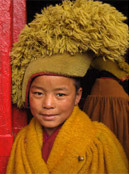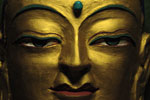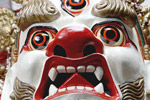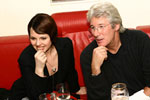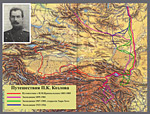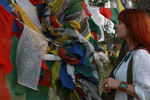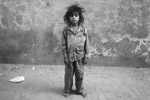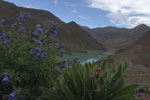Schools of Tibetan Buddhism
Tibetan Buddhism belongs to one of the trends of Mahayana Buddhism. In 5 th -6 th centuries the population of northern parts of India migrated to the neighboring countries, and also through Himalayan passes to Tibet . That time appeared Tibetan Buddhism, which broke off from Vajrayana under the influence of Indian tantrism. Buddhism was adapted to the Tibetan mentality interacting with local religions, mainly with bon. It was around 5 th century that Buddhism appeared in Tibet, then spread to the north of China, in 16-17 th centuries it came to Mongolia, Siberia, Tuva and Kalmykia. The historical sources of Tibetan Buddhism are available since the reign of the king of Tibet Srongtsen Gampo (6 20–650 ), who accepted Buddhism as the official religion because of the political matters.
Nyingma School
In the 8 th century the king Thrisong Detsen (790-858) invited to the Land of Snows Indian scholars Vimalamitra and Shantarakshita, and then the great guru Padmasammbhava (Guru Rinpoche). At that period first monasteries and big institutes appeared, and the oldest of the four main schools of Tibetan Buddhism Nyingma School ('The Ancient Ones' ), began to establish. But this first wave of Buddhism in Tibet was condemned to disappear during the reign of the King Langdarma, who tried to destroy everything that concerned Buddha's teachings. Fortunately, Padmasambhava and his enlightened spouse Yeshe Tsogyel managed to conceal many of the sacred texts in different difficult to access places of Tibet , leaving also the prophecies who and when is going to find them.
Kagyu School
After almost three hundred years Marpa the translator, brought to Tibet the teachings, which became the basis of another school – Kagyu or “Oral Transmission”. Marpa undertook three great journeys from Tibet to India , overcoming the snow Himalayan passes to study and practice the secret tantric teachings and then to transfer them to his nationals. Staring from the 12 th century the head of this school is Gyalva Karmapa, the first Lama in the history of buddhism, who consciously takes rebirth for the benefit of sentient beings. Short before his death Karmapa leaves directions to his closest disciples, either written or oral, concerning the time and place where his next incarnation has to be found. The enlightened Lamas preserve and transfer these teachings and enlightened experience to their students. That is why this is the school of oral transmission, straight transmission of the teaching of Mahamudra from the teacher to the student. The Kagyu teachings have been transmitted and preserved this way, in an unbroken line, until the present time.
Sakya School
Approximately the same time as Kagyu, Sakya school appeared. It gave the world many great scholars, masters of Buddhist philosophy and theory of knowledge. The name of the school comes from the name of the area 'Grey (Light) Earth'. Sakya tradition has been closely associated with the Khon Family. Khon Lui Wangpo Sungwa became a disciple of Guru Rinpoche in the eighth century. Through the next thirteen generations, the Dharma continued to be propagated through the Khon family. In 1073, Sakya Monastery was built by Khon Konchok Gyalpo which established the Sakya Tradition in Tibet.
Gelug School
The fourth school of Tibetan Buddhism - Gelug 'Way of Virtue' or the school of “the yellow hats”- is called so because of the color of the monks' hats. It was established in 14 th -15 th centuries by Gyalwa Tsongkhapa (1357-1419), who is worshiped as the emanation of bodhisattva Manjushri, who personifies wisdom and omniscience. Tsongkhapa wrote a huge work integrating many teachings and containing the guide ”The steps of the Way” (Lamrim in Tibetan). Tsongkhapa's disciple, Gyalwa Gedun Drukpa became the first of the fourteen successive rebirths of the Dalai Lama. According to the tradition Dalai Lama, who is the spiritual leader of Tibet has always been the representative of Gelug school and is also known to be the emanation of Avalokiteshvara – Bohisattva of Compassion. The present Dalai Lama, Tenzin Gyatso, was given the Nobel Peace Prize in 1989 in recognition of his tireless efforts on behalf of world peace and alleviating the sufferings of the Tibetan people under the genocidal policies of the Chinese government.
The teachings of all these schools bring to the same result, the state of enlightenment. But the methods are different: they are for different types of people. It is said that Ningma school possesses the methods, transforming mainly anger and pride, that's why people with whom these disturbing feelings are the strongest, practice in this school. To Karma Kagyu school come the people who are mainly dependent on the desires and attachment. In Gelug school the ignorance is transformed and in Sakya school approximately equal correlation of these disturbing emotions.
Rime School “Indivisible”
A non-sectarian or eclectic movement which crystallized during the nineteenth century in Eastern Tibet where the study and integration of all schools of Tibetan Buddhism were encouraged by the leading figures of that time, namely: Jamyang Khyentse Wangpo, Jamgon Kongtrul Lodro Thaye, Chogyur Dechen Lingpa, and Ju Mipham Gyatso. Rime unites ningma, kagyu and sakya schools for the missionary and enlightening purpose. A principal feature of the Rime movement was the emergence of a new literature. This consisted primarily of compendiums of major works of all the major and minor schools of Tibetan Buddhism on convergent topics of thought and practice. The followers of any school can visit the libraries of the two others and master their practices.
Bon
There are three different types of Bon tradition. It is the old Bon – completely shamanist, Yungdrung (or Eternal Bon) and New Bon, or reformed one.
The followers of Yungdrung Bon assert that they represent pre-buddhist civilization of Tibet . At least the part of this religious tradition originates not from Tibet, but was brought to the Central Tibet long before the 7 th century from the independent land of ZhangZhung situated to the west of Tibet, and there – from more remote places of tajik or iran-speaking Central Asia on the north-west. This form of Bon religion is known as Yungdrung Bon, “Eternal Teaching”, the term which corresponds to “Swastika Dharma” in Sanskrit, where swastika or the sun cross is the symbol of the eternal and indestructible, almost fully corresponding to the Buddhist term “vajra” or diamond. In addition to ritual texts, belonging to the shamanist and animist practice, this ancient tradition possesses a great amount of texts, also claiming to have pre-Buddhist origin, and belonging to the highest teachings of Sutra, Tantra and Dzogchen. Instead of adverting to the north-Indian prince Siddhartha Gautama as their Buddha and the source of the highest teachings of Sutra, Tantra and Dzogchen, the Bonpo Lamas accept the other prince, Sherab Mivoche, who lived in earlier ages in the land of Olmo Lungring in the Middle Asia, as their Buddha and the source of their teaching. Consequently he was given the title Tonpa or Teacher, literally “the one who reveals the secrets”. Bonpo tradition ascribes to Tonpo Shenrab really fabulous dates, claiming that he flourished approximately eighteen thousand years ago.
It is considered to be that starting from the beginning of reign of the second king of Tibet , Mitri Tsanpo, some of the bonpo texts, especially the Father Tantras were brought from Zhang-Zhung to the Central Tibet and translated into Tibetan language. One after another Bonpos suffered two cycles of prosecutions – the first was at the times of the eight king of Tibet , Drigum Tsampo, and then the second – at the times of the great Buddhist king of Tibet , Trisong Detsan in the eight century. According to the tradition in both cases the prosecuted Bonpo sages hided their books in different places in Tibet and adjacent regions, such as Bhutan . These caches have been anew discovered starting from the tenth century. That's why they are known as newly discovered texts or “hidden treasures” (terma). Some other texts were never hidden, but remained in use and were transmitted with the unbroken lineage starting from the eighth century. These texts are known as snyan-rgyud, meaning literally – “the oral transmission”, even though they existed as the written texts, starting from the early period. This type of the old Bon flourished in the West and Central Tibet till our days. The idea that many teachings appeared in the western part of Tibetan plateau but not on the Indian subcontinent, and that it happened long before the times of historical Buddha, seems almost unbelievable to those who is used to the generally accepted history that Buddhism penetrated to Tibet in the seventh century.
The second type of the Bon tradition is shamanist Bon. The Tibetan term Bon evidently comes from the old verb "bond-pa", that means “invoking the gods”. In this case Bon implies pre-buddhist shamanist and animist culture of Tibet , the culture having much in common with other shamanist tribal cultures of Central Asia and Siberia . Though these cultures included different kinds of the religious practice and beliefs, in the centre there always was a practitioner, known as shaman. The shaman's activity was characterized by entering modified state of mind with the help of rhythmic chanting, drum beating, dancing and so on. The main social function of such a practitioner was healing. The traditional form of the central Asian shamanism, including being possessed by the spirits is widely spread in Tibet nowadays among the Buddhist people as well as people practicing Bon, and also among Tibetan refugees living in Ladakh , Nepal and Bhutan .
In fact in accordance with Bonpo tradition, some of these practices, such as the gods' invocations and the rituals of conjuring away the evil spirits were taught by Tonpa Sherab himself in the pre-historic times, during his short stay in Kongpo, in South-eastern Tibet . These shamanist kinds of practices are known today as the “Causal ways of Bon”. Teachings and practices, contained in these Causal Ways , are considered dualistic in their philosophical views. That is to say, the gods, representing the powers of Light and Order, which are called Ye, and the demons, representing the evil powers of Darkness and Chaos, called Ngam, have independent existence, and the practitioner is mainly occupied with making the rituals, appealing to the positive energies of gods and averting the negative influences of demons and evil spirits. However, as well as Buddhism in the whole, Yungdrung Bon completely denies the practice of the bloody sacrifices, for the origin of these practices relates to the demons-cannibals Sinpo, but not Tonpa Shenrab. Thus, Bonpo Lamas don't want to identify even the Causal Ways of Bon with Djangkris shamanism or the shamans still existing in the mountains of Nepal .
New Bon appeared in the fourteenth century and is lasting till nowadays. It was based on the opening of the terma system. In the whole, this system is rather similar to Nyingmapa, and Padmasambhava is also considered an important person there. In fact, some Tertons, like Dorje Lingpa, revealed both Nyingmapa and Bonpo Termas. New Bon flourishes mainly in the Eastern Tibet .
Like Nyingmapa among Tibetan Buddhists, Bonpo tradition, as its highest teaching, contains the system of knowledge known as Dzogchen, “The Great Perfection”. These teachings reveal man's Primeval State in the ingenious experience, in other words, the essential born Buddha nature or Bodhichitta, which is beyond the limits of time, conditionality and conceptual limitations. This Natural State is described in the terms of its essential pureness and its spontaneous perfection in appearance. Both Buddhist nyingmapa and Bonpo claim that their traditions of Dzogchen were brought to the Central Tibet in the 8 th century: Nyingmapa transmission tradition – from Mahasiddha Shrisimh, who lived in Nothern India, and Bonpo tradition came from the Mahasidha lineage, who lived in the area of Kailas Mountain and the lacustrine land of ZhangZhung to the west and north of Tibet. Thus, obviously, there are two historically authentic transmission lineages of these teachings.
Present-day Bon contains the monastic system, very similar to the Buddhist monastic system, and also Madhyamika philosophy completely comparable with the other schools of Tibetan Buddhism. According to the Bonpo lamas, the main difference between Bon and Buddhist schools is rather not the difference in teachings and doctrines, but in the transmission lineages, for the Bonpo consider Tonpa Sherab as their founder, and the Buddhists – Buddha Shakyamuni. As a matter of fact, both these outstanding personalities are the manifestations of Buddha's enlightenment in our world, of the insight technically known as Nirmanakaya. His Holiness Dalai Lama recognized Bon as the fifth religious school of Tibet along with Nyingma, Sakya, Kagyu and Gelug, and granted to the Bon representatives the places in the Council of the Religious Affairs in Dharmsala.
See also:
Buddhist centers and communities in Moscow
![]()
![]()
![]()
![]()
